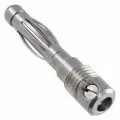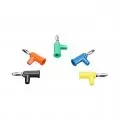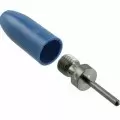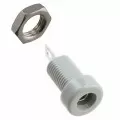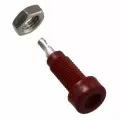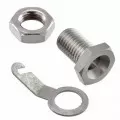OUTLINE:
What Is a Banana Connector: A Complete Introduction
 445
445Ever looked at the back of your audio equipment and seen those colorful plugs poking out? Those, my friends, are banana connectors, and they're much more than just their fruity namesake. What is a banana connector? Let's learn about this complete guide!
What Is a Banana Connector
A banana connector is a single-wire (one conductor) electrical connector used for joining wires to equipment. Widely used in audio and electronic testing applications, banana connectors are known for their simplicity, reliability, and ease of use. They come in various forms, including plugs and jacks, and offer several advantages over other types of connectors. It consists of a cylindrical metal pin (resembling a banana) with a spring-loaded collar or a metal shroud around it.
The name is a reference to a protruding prong that bulges slightly in the center, called a banana due to its supposed resemblance to the fruit.
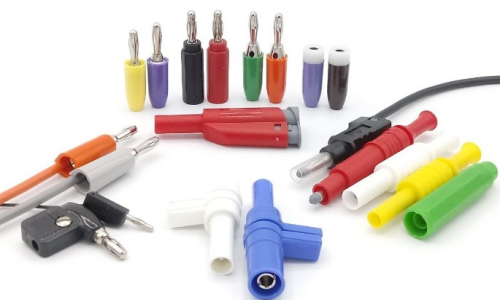
Design and Construction
A typical banana plug consists of a cylindrical pin with a diameter of 4 mm (0.16 inches). The slightly raised center portion of the plug ensures a snug fit into the jack, strengthening the electrical connection. The plug gets its name from its shape, which resembles a banana. Connectors are usually made of brass or copper and plated with materials such as gold or nickel to enhance electrical conductivity and to prevent corrosion.
Types of Banana Plugs
There are several types of banana plugs, each of which has unique features and benefits.
Banana Plugs
These are the male components of the connector system, featuring the characteristic banana-shaped pin. They are used to connect speaker wires to audio equipment or to make temporary connections in test equipment.
Banana Jacks
These are the female components, designed to receive the banana plug. They are often mounted on equipment panels and can be used for permanent connections in audio and test equipment.
Stackable Banana Connectors
These allow multiple connections to be made from a single output, useful in situations where several devices need to be connected simultaneously.
Banana Plug Sizes
The most common size of banana plug is the standard 4 mm, although smaller and larger versions are available. The different sizes of banana plugs and their typical uses are detailed below:
Standard Banana Plug
The most widely used size, with a pin diameter of 4 mm (0.16 inches). This size is considered the industry standard and is compatible with most consumer audio equipment and test equipment.
Commonly used to connect speakers to amplifiers in home audio systems, laboratory test equipment and educational electronics kits.
Mini Banana Plug
Mini banana plugs are smaller than the standard size, with pins usually around 2mm in diameter. They are designed for applications where space is limited or smaller conductors are used.
Ideal for small audio systems, portable electronic devices, and other small spaces.
Large Banana Plug
Larger than standard 4 mm plugs, up to 5 mm or more in diameter. They are designed for high-power applications that require a larger wire gauge.
Use in professional audio equipment, high power amplifiers, and industrial test environments requiring greater current capacity.
What Are Banana Connectors Used for
Banana connectors provide a tidy and safe way to connect wiring to equipment via compatible banana sockets.
Audio/Video: Because of their safe and fast-to-disconnect design, banana plugs are frequently utilized with speaker wires and audio equipment. They provide a neater, more polished appearance and remove the inconvenience of exposed wiring.
Testing and Measurement: Banana plugs make it simple to connect cables and instruments in lab settings and electronics projects, which promotes effective testing and experimentation.
Power Systems: For dependable and practical power delivery, certain high-end power supplies for gadgets like ham radios use banana plugs.
How to Use Banana Plugs
With these steps in your pocket, banana plug installation will be a breeze!
1. Preparing the Wire
Measure Cut: Start by measuring enough speaker wire for your setup, adding 1-2 feet of slack for wiggle room.
Positive Power: Identify the positive side (red wire or marked side) – crucial for correct polarity.
Strip Twist: Strip 3/4-1 inch of insulation from both ends of both sides of the wire. Twist the exposed copper ends for a snug fit.
Solder (Optional): For extra security, solder the twisted ends. Keep it to the tip and avoid covering too much copper.
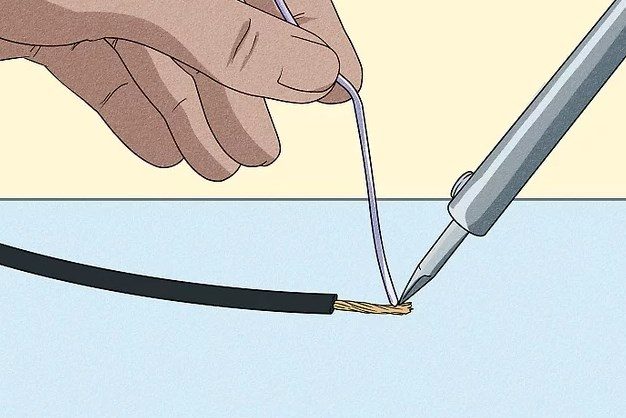
2. Attaching the Plug
Plug Power: Choose your plugs - positive with a red mark, negative with black or bare. Keep pairs matched!
Unlock the Plugs: Unscrew the bottom of each plug, following their design (sleeve/screw or side screws).
Positive Pass: Feed the positive wire into the red plug's hole until it touches the other side and insulation aligns.
Lock Load: Tighten the screw or sleeve depending on your plug model.
Repeat Reverse: Do the same for the negative side, then repeat steps 6-8 for the other end of the wire. You'll end up with 4 plugged wires.
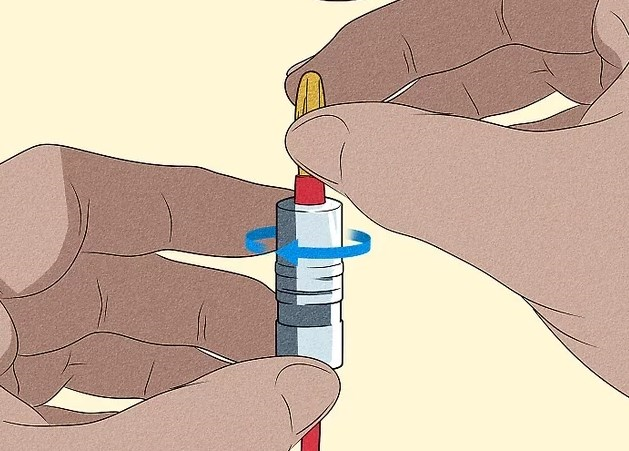
3. Plug Play
Match Connect: Push the red plug into the red port on your speaker/receiver, and black into black.
Signal Transmission: With the plug inserted into the jack, the electrical signal can travel from the wire through the plug and into the connected device, such as a speaker or an amplifier. The tight fit of the banana pin ensures consistent contact, reducing signal loss and maintaining sound quality.
Advantages of Using Banana Connectors
Ease of use: They are easy to install, simply stripping the wires and plugging them into the connectors. In other words, they are designed to be simple and straightforward, allowing for fast and secure connections without the need for specialized tools.
Versatility: Banana connectors are available in different sizes, such as 2 mm and 4 mm, providing flexibility to meet a wide range of requirements. In short, they are suitable for a wide range of applications, from audio systems to test and measurement equipment.
Reliability: The close fit of the plug and jack ensures a stable connection that reduces the risk of accidental disconnection.
The Difference Between Bullet Connectors and Banana Plugs
Banana connectors are different from bullet connectors, which are cylindrical connectors with a solid metal pin.
While both connectors are used for electrical connections, banana plugs are typically used for low-current and low-voltage applications, such as audio signals;
Bullet connectors are often used for higher-current applications, such as automotive or power distribution systems.
Summary
Now you can know what is a banana connector and its importance. Banana plugs work by providing a stable and efficient connection between cords and equipment, ensuring reliable signal transmission. With these small buddies by your side, you may confidently explore the world of audio, electronics, and testing with this information.

Disclaimer: The views and opinions expressed by individual authors or forum participants on this website do not represent the views and opinions of Chipsmall, nor do they represent Chipsmall's official policy.

share this blog to:


